LTO Restriction Codes 2023: A Definitive Guide
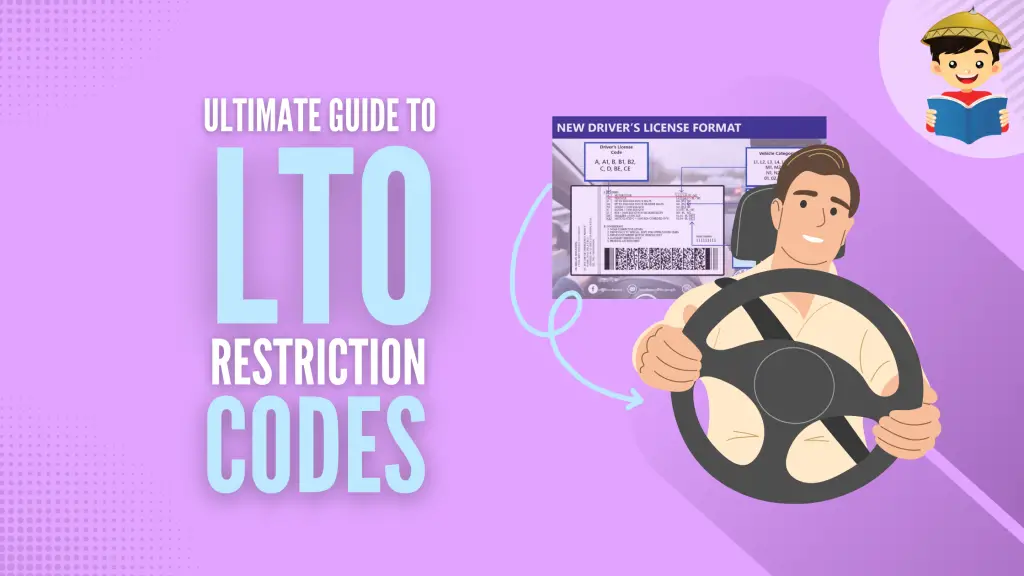
Applicable restriction and condition codes are indicated in an individual’s Professional or Non-Professional Driver’s License. Here’s everything you need to know about them.
Table of Contents
Updated LTO Restriction Codes: Driver’s License (DL) Codes
When you successfully get a driver’s license, you must know which types of motor vehicles you’re allowed to drive. This is where restriction codes apply.
If you’re caught driving a type of vehicle that you’re not licensed to drive, you can face penalties and charges. For example, you’re prohibited from driving a bus if your driver’s license indicates you can only drive a car. Once caught driving a restricted vehicle, you must pay a fine of PHP 3,0001, not to mention the possibility of you being unable to avail of the 10-year validity license and your vehicle being impounded.
The Land Transportation Office (LTO) has recently updated the restriction and condition codes to specify which vehicle/s you are licensed to drive.
Restriction codes belong to the old restriction system that LTO used. These codes are what most motorists are familiar with. Restrictive codes are located at the front of the license and use numerical codes 1 to 8 with their respective vehicle categories. In 2021 these old numerical restriction codes were replaced by Driver’s License (DL) codes that use alphanumeric codes found at the back of the license. Each alphanumeric code corresponds to a specific type of vehicle that the owner may operate.
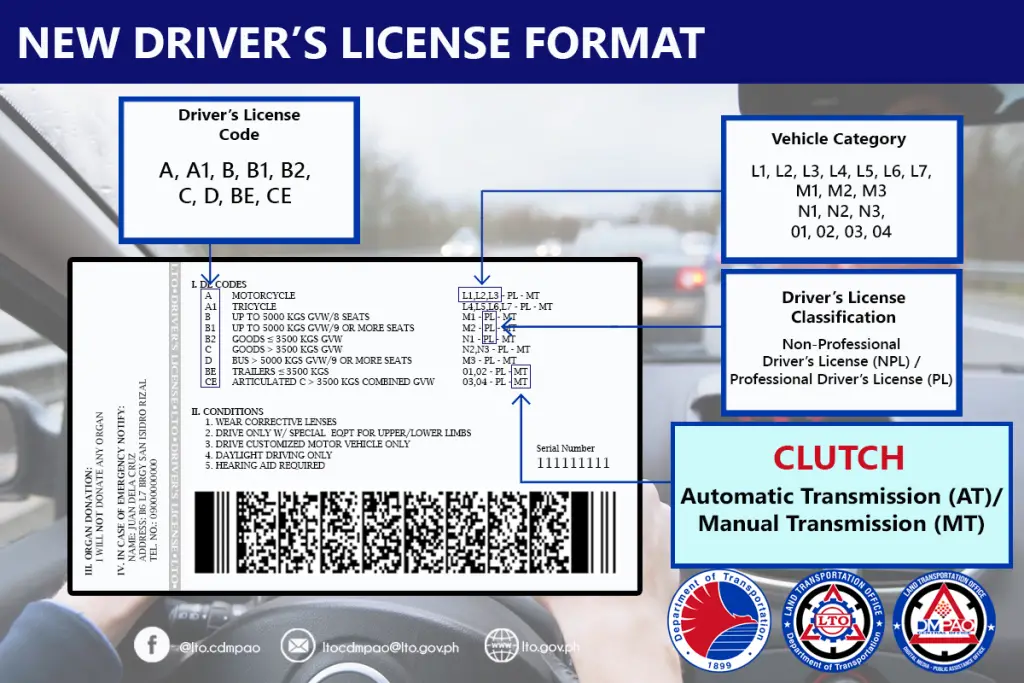
Nine DL codes, ranging from A to CE, represent general types of vehicles. For example, DL Code A pertains to all kinds of motorcycles; DL Code A1 pertains to all types of tricycles; DL Code B pertains to all kinds of passenger cars, and so on2.
Under each DL code, more specific subcategories called Vehicle Category codes indicate the types of vehicles each DL code holder may operate. The Vehicle Category codes are on the right of the DL codes at the back of the license. For instance, DL code A has vehicle category codes L1, L2, and L3. Continue reading this article to know what these codes mean.
What Are the LTO Driver’s License Codes and Vehicle Category Codes?
Here are the nine DL codes together with their respective vehicle category codes3.
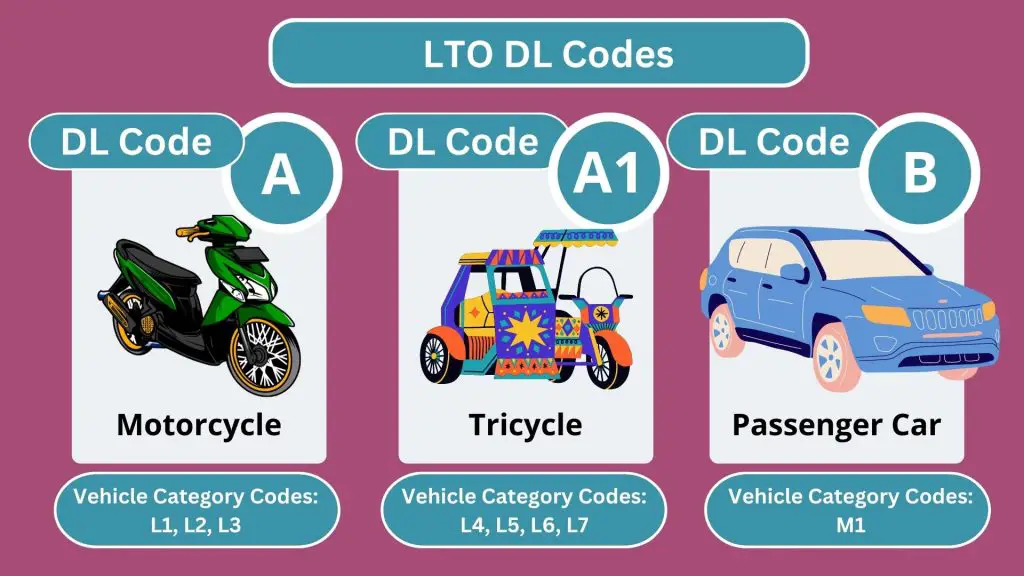
1. DL Code A: Motorcycle
If you want to drive any motorcycle model in the Philippines (e.g., Mio, Aerox, NMax, Smash, Barako, etc.), your license should have DL Code A. This DL code covers all types of transmissions (Automatic, Manual, and Semi-automatic).
License holders with DL Code A can drive the following Vehicle Category Codes:
- L1: Two-wheeled vehicle with a maximum design speed not exceeding 50 kph
- L2: Three-wheeled vehicle with a maximum design speed not exceeding 50 kph
- L3: Two-wheeled vehicle with a maximum design speed exceeding 50 kph
2. DL Code A1: Tricycle
This DL Code covers all three-wheeled motor vehicles (and motorcycles with sidecars). They include transport tricycles and e-tricycles such as Bajaj Re, Yamaha Tricity4, and tuk-tuk ( or bokyo).
Note that this code also covers four-wheeled vehicles with limited unladen mass (i.e., weight when not carrying passengers or other items) and maximum design speed.
License holders with DL Code A1 can drive the following Vehicle Category Codes:
- L4: Motorcycle with sidecar with a maximum design speed not exceeding 50 kph
- L5: Three-wheeled symmetrically arranged vehicles with a maximum design speed exceeding 50 kph
- L6: Four-wheeled vehicles with unladen mass not more than 350 kg with a maximum design speed not exceeding 45 kph
- L7: Four-wheeled vehicles with unladen mass not more than 550 kg with a maximum design speed not exceeding 45 kph
3. DL Code B: Passenger Car
This DL Code covers all car models with up to 8 seats and a mass not exceeding 5000 kg. These include hatchbacks, coupes, sedans, and SUVs5.
There’s only one Vehicle Category Code under DL Code B, M1.
- M1: Vehicles with fewer than eight seats and Gross Vehicle Weight (GVW) not exceeding 5000 kg.
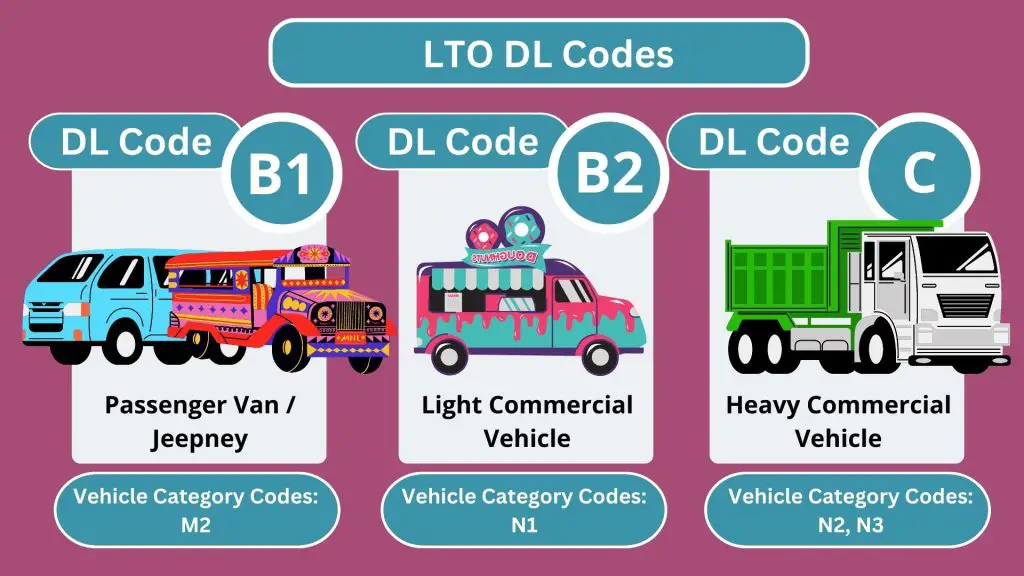
4. DL Code B1: Passenger Van or Jeepney
This covers all passenger van models (e.g., Honda Odyssey, Toyota Hiace, Ford Transit, etc.) and the popular mass transport jeepney model.
The Vehicle Category Code under B1 is
- M2: Passenger vehicles with more than eight seats and GVW of less than 5000 kg.
5. DL Code B2: Light Commercial Vehicle
This covers all cargo four-wheelers transporting goods and other items for business or commercial purposes. Some vehicle model examples are Suzuki Carry, Hyundai H100, Isuzu Travis, and Mitsubishi L300.
The Vehicle Category code under B2 is
- N1: Vehicles used for the carriage of goods, with a maximum GVW not exceeding 3500 kg.
6. DL Code C: Heavy Commercial Vehicle
Large trucks such as garbage, container, and fire trucks belong to this DL Code.
There are two Vehicle Category codes under this DL Code:
- N2: Vehicles used for the carriage of goods, with maximum GVW exceeding 3500 kg but less than 12000 kg.
- N3: Vehicles used for the carriage of goods, with maximum GVW exceeding 12000 kg.
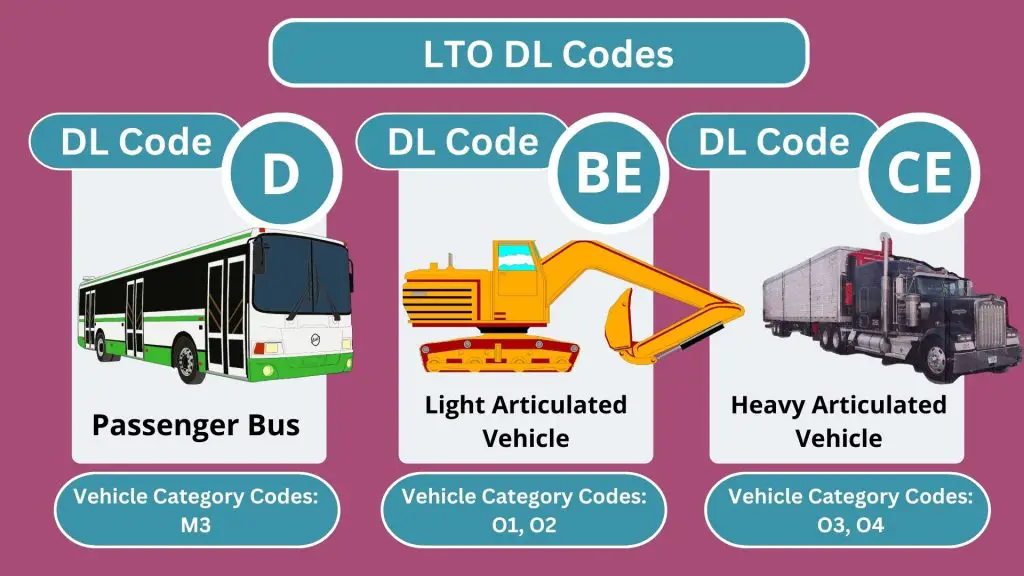
7. DL Code D: Passenger Bus
Bus drivers should have DL Code D on their licenses to operate any bus model in the Philippines.
There’s only one Vehicle Category code under DL Code D:
- M3: Vehicles with more than eight seats and a maximum GVW of more than 5000 kg.
8. DL Code BE: Light Articulated Vehicle
Light articulated vehicles have permanent or semi-permanent pivot joints with lower GVW, like cars with trailers. The Vehicle Categories under this DL Code are
- O1: Articulated vehicles with GVW less than 750 kg
- O2: Articulated vehicles with GVW not exceeding 3500 kg
9. DL Code CE: Heavy Articulated Vehicle
The only difference between this DL Code and the previous one is that this has a higher Gross Vehicle Weight requirement. The Vehicle Categories under this DL Code are
- O3: Articulated vehicles with GVW exceeding 3500 kg but less than 10000 kg
- O4: Articulated vehicles with GVW exceeding 10000 kg
Here is a summary from LTO to help you get a better picture:
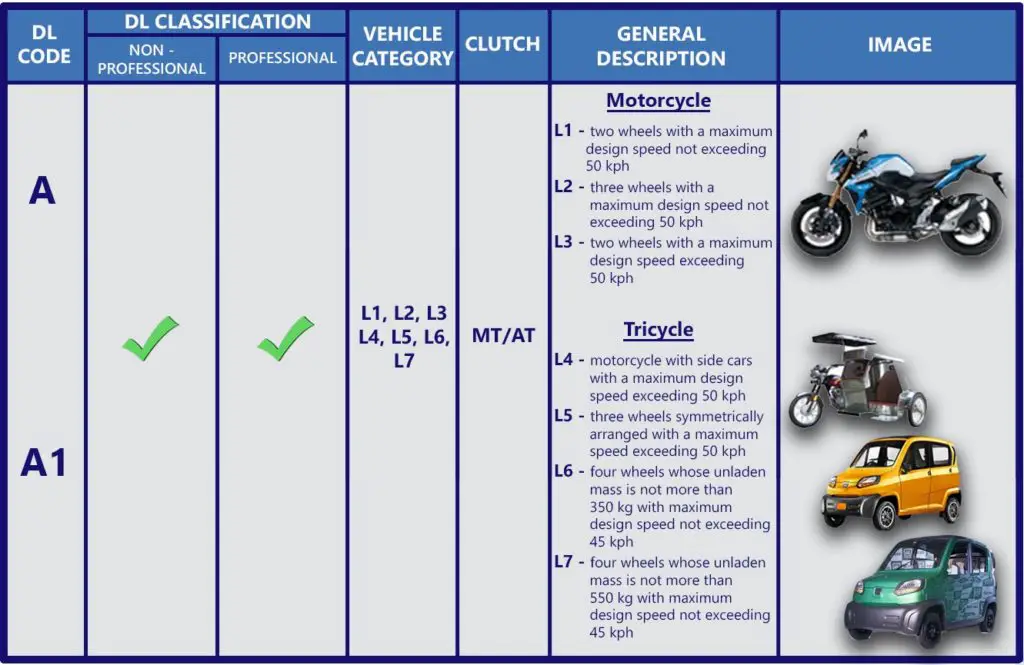

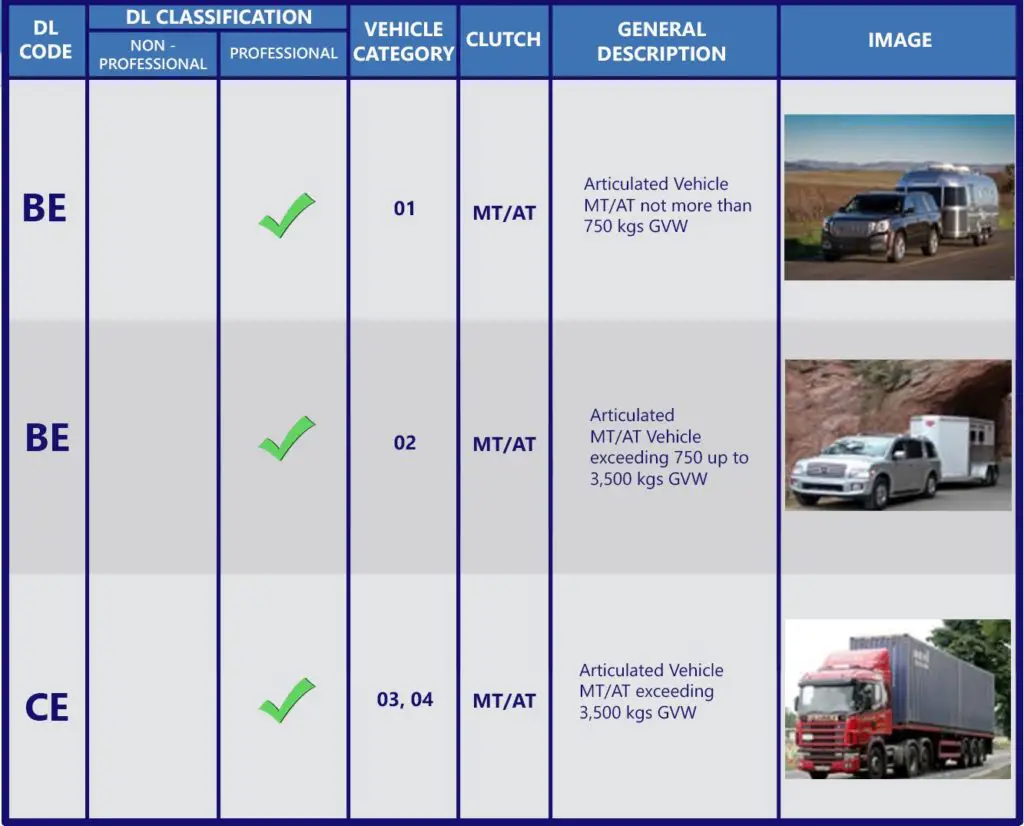
Related: How to Apply for Additional Restriction Codes On Your Driver’s License
What Are the Equivalent DL Codes of Previous Restriction Codes?
The basis for vehicle classification in the previous restriction codes is Gross Vehicle Weight (GVW) and clutch type only. This makes the old system open for misinterpretation. LTO set a more comprehensive restriction system based on GVW, seat number, and maximum vehicle design speed to create a more standardized restriction system.
The table below presents the equivalent DL codes of old restriction codes according to LTO:
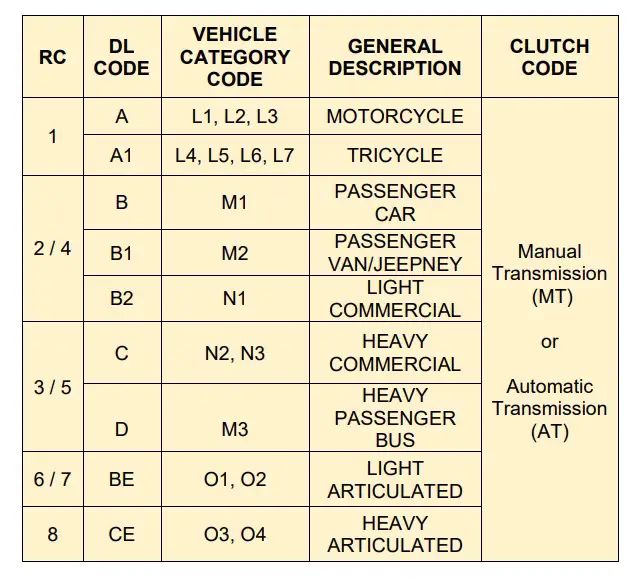
The table shows that restriction code 1 has been replaced and separated into two DL Codes: A and A1. DL Codes B, B1, and B2 have replaced restriction codes 2 and 4. Meanwhile, restriction codes 3 and 5 have been replaced by DL Codes C and D, whereas DL Code BE replaces restriction codes 6 and 7. Lastly, restriction code 8 has been replaced by DL Code CE.
How To Read LTO Driver’s License Codes
The codes at the back of your license and directly on the right of each DL code consist of three components:
- Vehicle Category
- License Classification (Professional/Non-Professional)
- Transmission/Clutch
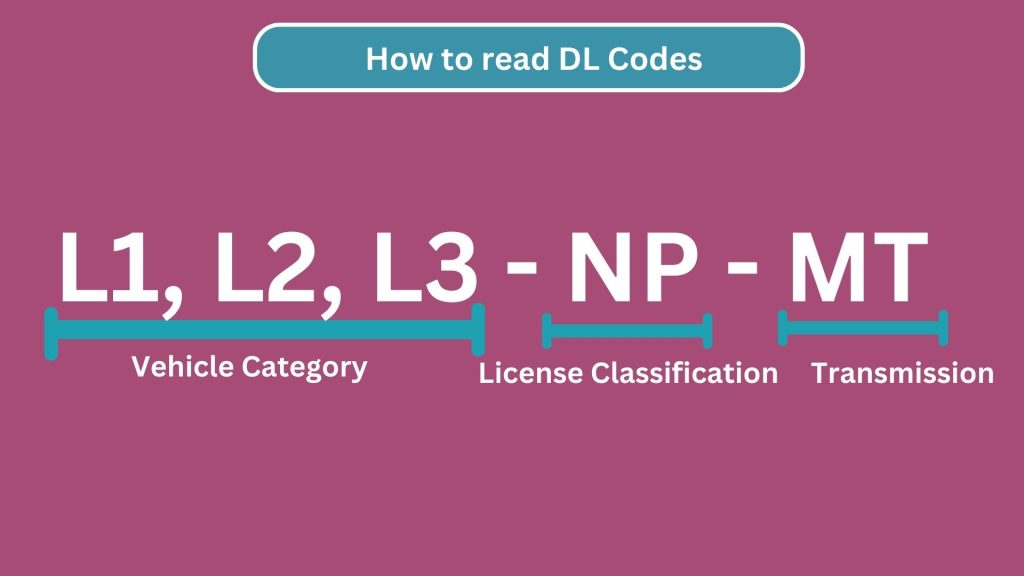
The first set of alphanumeric codes indicates the vehicle categories you can operate. In the example above, L1, L2, and L3 pertain to different types of motorcycles under DL Code A (Please refer to the previous section for the respective meanings of the vehicle category codes).
The second code pertains to license classification. If “PL” appears, the license is a professional one. Meanwhile, if “NP” appears, it is a non-professional license. In the example above, the license is a non-professional license.
The last alphanumeric code in the line indicates the transmission type or clutch. “MT” refers to a manual transmission, while “AT” refers to an automatic transmission. Note that if the restriction indicates “MT,” you can operate both manual and automatic transmissions. If the restriction is “AT,” you can only drive automatic transmissions.
Example 1: Let’s try to read this code: N1 – PL – MT.
- Vehicle Category: N1 is under DL Code B2, which refers to light commercial vehicles transporting goods or other items.
- License Classification: PL means Professional License.
- Transmission/Clutch: MT means Manual Transmission.
Example 2: Let us identify the meaning of this code: M1 – PL – AT
- Vehicle Category: M1 is under DL Code B, which pertains to vehicles with up to 8 seats and a maximum GVW of 5000 kg.
- License Classification: PL means Professional License.
- Transmission/Clutch: AT means Automatic Transmission.
Example 3: Now, let us try to read this code: L4, L5, L6, L7 – PL – MT
- Vehicle Categories: L4 to L7 are under DL Code A1, which pertains to all tricycles.
- License Classification: PL means Professional License.
Transmission/Clutch: MT means Manual Transmission.
Updated LTO Condition Codes
The practical driving test will assess your ability to operate a vehicle. Depending on your needs, it will identify which conditions apply to you.
The conditions will help you drive safely. For example, if you have problems driving without eyeglasses, your driver’s license indicates a specific condition.
Here’s the updated list of condition codes that may or may not be indicated in your driver’s license:
| Code | Condition |
| 1 | Wear corrective lenses |
| 2 | Drive only w/ special equipment for upper/ lower limbs |
| 3 | Drive customized motor vehicle only |
| 4 | Daylight Driving only |
| 5 | Hearing aid required |
It must be noted that an LTO driver evaluator will assess the special driving conditions or special equipment that must be used.
The old condition codes (A, B, C, D, E) have been replaced with numbers. Condition 1 is for individuals wearing contact lenses or eyeglasses to drive the vehicle.
Condition code 2 is given to drivers with upper or lower limb impairment, whereas the old system puts them under two different codes depending on which parts are affected.
On the other hand, condition 3 is a new addition. It refers to motor vehicles personalized to address the unique disability of an individual not belonging to other conditions. Condition 4 has been unchanged.
Lastly, condition five has been updated to allow the individual with hearing loss to drive the car without the aid of a person with normal hearing.
To have a better grasp of the DL codes and the conditions combined, here are a few examples:
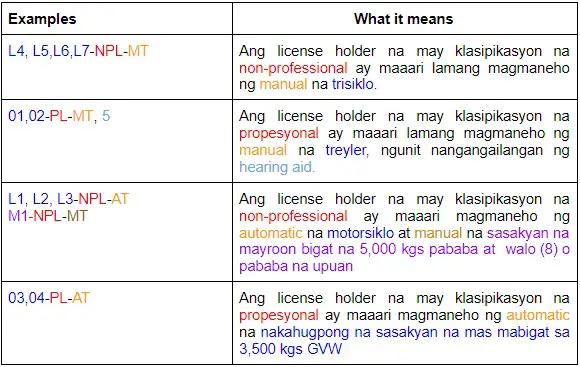
Go back to the main article: How to Apply for a Driver’s License in the Philippines: An Ultimate Guide
References
- Exec. Order No. Joint Administrative Order No. 2014 – 01, 3 C.F.R. (2014).
- Guinto, A., CSEE. (n.d.). Filipino Diver’s Manual. Retrieved December 14, 2022, from https://lto.gov.ph/images/Transparency/FDM%20Vol.%201%20(2nd%20Edition).pdf
- Boi, R. (Producer). (n.d.). Mga pinalitan at dapat mong malaman sa bagong LTO updates new driver’s license codes 2022 [Video file]. Retrieved December 14, 2022, from https://www.youtube.com/watch?v=ETJKy5lwClg
- Roces, I. (2021, January 08). New driver’s license codes: What can you drive? Retrieved December 14, 2022, from https://mb.com.ph/2021/01/08/new-drivers-license-codes-what-can-you-drive/
- Boi, R. (Producer). (2022, June 04). Mga pinalitan at dapat mong malaman sa bagong LTO updates new driver’s license codes 2022 [Video file]. Retrieved December 14, 2022, from https://youtu.be/ETJKy5lwClg?t=174
Copyright Notice
All materials contained on this site are protected by the Republic of the Philippines copyright law and may not be reproduced, distributed, transmitted, displayed, published, or broadcast without the prior written permission of filipiknow.net or in the case of third party materials, the owner of that content. You may not alter or remove any trademark, copyright, or other notice from copies of the content. Be warned that we have already reported and helped terminate several websites and YouTube channels for blatantly stealing our content. If you wish to use filipiknow.net content for commercial purposes, such as for content syndication, etc., please contact us at legal(at)filipiknow(dot)net